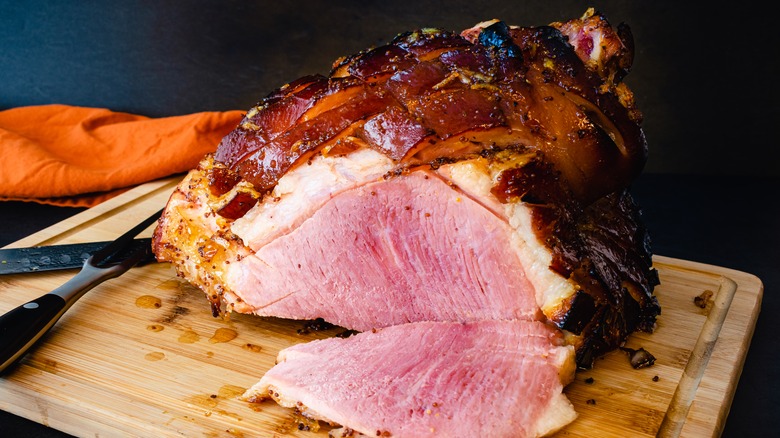What Is The Best Type Of Board For Cutting Meat?
Cutting boards are a must-have in any cook's arsenal. You will have to use a knife at some point, and a suitable surface is invaluable. There are many cutting board mistakes you might be making, including not choosing the right surface for cutting meat. It's a good idea to have at least two cutting boards to avoid cross-contamination: One for raw meats, and the other for cooked meat and vegetables. The criteria for choosing the best board for your meat-cutting needs overlap whether it is used for raw or cooked meat.
First of all, is it large enough? Unless you only get small, trimmed cuts of meat at the butcher, you will likely need a cutting board on the larger side to accommodate a hunk of meat. Another important feature you need in a meat cutting board is the ability to collect liquid run-off from the meat. A popular design incorporated into many cutting boards is a well or divot that runs along the sides of the board. This helps prevent meat juices from running onto your kitchen counter. It is also essential to have your board stay in place and not slip around as you are using it. This can be solved by using cutting boards that have non-slip pads attached, or boards that are on the heavier side. As long as your board is large enough, can catch juices, and doesn't move around on the counter, it will be good for cutting meat, regardless of whether it's plastic or wood.
Features of plastic cutting boards
The features mentioned above work no matter the material of the board, but different materials have different pros and cons. Let's get into that next, starting with one of the most popular: plastic cutting boards.
Being a nonporous material, plastic is far easier to both clean and sanitize than other materials. If you regularly handle raw meats, poultry, and fish, this is an essential feature. Soaking a plastic cutting board in a weak solution of bleach and water after preparing raw meat will eliminate any germs present. Its nonporosity also makes it easy to chuck into the dishwasher for cleaning, something you should not do with cutting boards made of wood.
Unfortunately, plastic is not the most attractive material compared to wood. This means that it is not the best choice to use as a serving platter, and you will have to transfer your sliced, cooked meat to another dish for serving. Plastic also takes on the dings and nicks of a knife much more easily than wood, leaving visible knife marks after just a few uses.
Wooden cutting board pros and cons
The other major material used for cutting boards is wood. These boards are far more sustainable than plastic boards, by sheer virtue of them being made of organic and renewable materials. Wooden cutting boards also work well as serving boards for cooked meats, as they are more aesthetically pleasing than plastic. The surface of a wooden cutting board can also be sanded and seasoned periodically to reduce the appearance of knife marks.
Cleaning wooden cutting boards can be a bit of a challenge. They should not be washed in the dishwasher, which means that sanitizing them after cutting raw meat requires more effort than sanitizing plastic boards. That said, wooden cutting boards are undeniably more beautiful, especially if you take care of them and oil them regularly. And as long as you keep a separate wooden cutting board specifically for raw meat, cross-contamination shouldn't be much of a concern. With proper maintenance, wooden boards can last for years before needing to be replaced. This can justify their (generally) higher price tags.


